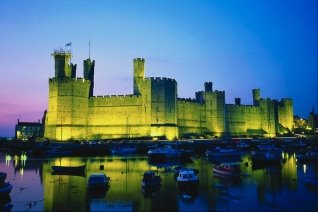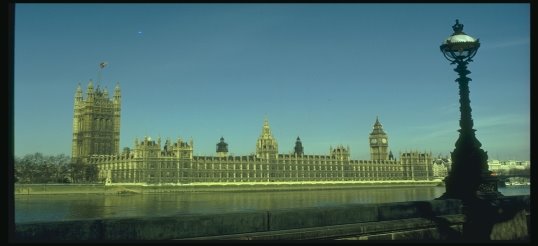Матеріал до уроку "Getting to Know Great Britain"
Матеріал до уроку про вивчення історії Великої Британії. Дана робота поглиблює знання учнів про Велику Британію, надає відомості про історію та культурні пам'ятки країни.










![]()
The United Kingdom of Great Britain and Northern Ireland is situated on
the British Isles. They lie to the north-west of Europe and include two large islands – Great Britain and Ireland and some five thousand small islands. Great Britain (or simply Britain), as you know, is the largest island of the British Isles. It is divided into three parts: England, Scotland and Wales. England is the southern and central part, Scotland is in the north of the island, and Wales is in the west. And what is the United Kingdom of Great Britain and Northern Ireland? – The UK is that part of the British Isles which consists of Scotland, Wales and England (the whole of Great Britain), and also Northern Ireland which is situated in the north-eastern part of Ireland.
Great Britain is separated from the continent by the narrow strait of water which is called the English Channel. From the west the country is washed by the Atlantic Ocean, from the east by the stormy North Sea. The Irish Sea lies between England and Ireland.
The nature of the British Isles is picturesque. There are many rivers and very beautiful lakes in the country. The mountains in Britain are not very high, but they are very beautiful. The most mountainous region is Scotland with the highest peak Ben Nevis, which is also the highest one in Britain. In Wales there are also many beautiful mountains and valleys. The highest mountain in Wales is Snowdon. Wales is also
a country of lakes. It has the most famous lake in the world – Loch-Ness.
There are many rivers in Great Britain, but they are not very long. The Severn is
the longest river in Britain but the Thames is the most important one. The Thames is rather wide and deep. The capital of the United Kingdom, London, stands on this river. Scotland’s most important river is Clyde, on which stands Glasgow. As the country is surrounded by seas from all sides there are some great ports at the seaside: London, Glasgow, Liverpool, Plymouth and others.
The climate of each country much depends on its geographical position. As we know, Great Britain is situated on islands. Seas and oceans influence the British climate. It is not very cold in winter and never very hot in summer. The weather changes very often and it rains in all seasons. Britain is known as a very rainy and foggy country. The Gulf Stream, bringing warm waters to the British shores, makes
the climate of the country mild and damp. There is no ice on the lakes and rivers
in winter. The rivers do not freeze, and snow never lies on the ground for long, except in the north, especially in the Highlands of Scotland.

![]()
There had been no towns in Britain before the Romans conquered it. People lived in small villages along the rivers or near the sea. They caught fish, grew wheat and had many pigs, cows and sheep. Later they learned to make things of wool and metal and sold them to the people who came across the sea. As soon as the Romans with Julius Caesar at the head had invaded the British Isles, they began to build towns, splendid villas, public baths as in Rome itself. England was added to the Roman Empire in 43 A.D. Roman invasion played a very important role in the history of the country. The Romans built the first roads, dug the first wells. The Romans were great road-makers and now a network of roads connected all parts of the country. The chief Roman roads are still among the highways of modern England. The Romans, who were great architects, constructed the first towns in Britain. York, Gloucester, Lincoln and London became the chief Roman towns. The Romans left the country only in the second half of the 5th century.
After the withdrawal of Roman legions, different tribes tried to control the territory of Britain. But the Normans influenced the British civilization most of all. They came in 1066 under the leadership of William the Conqueror. As the invaders spoke French, their speech influenced the English language. That is why English comprises a lot of French words and word combinations.
Once more the British had to face the French in 1805 at the battle of Trafalgar. Then Admiral Nelson won a great victory over the French fleet. In order to commemorate this event the main square in London was named after this battle. And the monument to Admiral Nelson was erected on this square.
Many historical events and personalities led the country to the position of the powerful and highly-developed state.
There are a lot of interesting places in Great Britain. They are both modern and ancient monuments, like Stonehenge and Hadrian Wall, Durham Castle and York Cathedral. The famous Lake District is in Northern England. In York the tourists are usually attracted by the National Railway Museum. But the main attraction is London’s places of interest.
The Englishmen love their country and take care of it. Everyone who comes to Great Britain says that it looks like one great beautiful park.


![]()
It’s a common knowledge that Englishmen have sentimental love for everything old. The traditions born in the past are kept everywhere in the United Kingdom. Many monuments, palaces, churches and other historical places hold the history of the whole nation. The capital of Great Britain is an ancient city. London is at least two thousand years old. It is one of the most beautiful cities in the world. London is famous for its historical places all over the world. From Tower Bridge you can see the Tower of London. It is like a mirror of many important events in the English history. Many centuries ago it was a fortress, a royal palace and then a prison. Nowadays it is a museum of arms. There are hundreds of interesting collections in it. There is a famous clock tower in London called Big Ben. It is the largest clock in England and the symbol of London. You can see magnificent churches in the city. Westminster Abbey is one of the oldest royal churches. Another famous church is St. Paul’s Cathedral. It is the most wonderful classical church in Britain and the second biggest cathedral in the world. One more interesting place in London is Buckingham Palace. It is the official London residence of the Queen and her family. London has many fine squares. Trafalgar Square is the central square of the city. It is famous for its Nelson’s Column. Not far from it there is the National Gallery, which has got the fine collection of European paintings. The British Museum, which is also in London, has the largest library in the world. London is also famous for its beautiful parks, such as Hyde Park, Regent’s Park and some others. The oldest metro in the world, called Tube, is here in London, too.
As you can see, London is a great historical and cultural centre of the country.

![]()


Tower Bridge The Tower of London


Westminster Abbey St. Paul’s Cathedral

The Houses of Parliament

London is a very old city. It is at least two thousand years old. The history of London begins about the year A.D. 43, when the Romans were in possession of the southern part of Britain and founded a military station on the present site of London. London was not built as a city in the same way as Paris or New York. It began life as a Roman fortification at a place where it was possible to cross the River Thames. A wall was built around the town for defence. Here on the banks of the Thames there had been a small settlement named Llyn-din when Caesar came to this place in the year 55 BC. Llyn-din became Londinium. The Romans made Londinium a large and reach city with good streets, beautiful palaces and shops. London was an important city in Roman times. In the 5th century the Romans left Britain and other nations came and ruined the city. Londinium had lain in ruins for nearly 400 years when in the 9th century the Saxon kings began to rebuild the city. In 1066 it became the capital of Britain and was called London. By the Middle Ages, when London became the political and commercial capital of England, it was one of the most important cities in Europe.
Now London is one of the largest and most beautiful cities in the world. As London lies in the valley of the Thames, not far from the sea, it is also one of the biggest ports. London has no one single centre. It arose from a number of towns and villages which have become parts of Greater London. Some of the names of those villages you can find in the names of the streets in modern London – Kensington, Westminster and others. Some 9 million people now live in London and its suburbs, and the city
covers an area of 620 square miles, making it one of the largest of the world’s capitals. One reason for its size is the preference of the English for the terraced houses and small gardens. As a result less than 5,000 people live in the oldest part of London.

The Tower of London

The White Tower – the keep of
the Tower of London.
It was built by the Normans between 1078 and 1090, on the site of an earlier wooden castle put up as soon as William the Conqueror arrived in London.


про публікацію авторської розробки
Додати розробку
